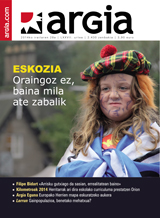Tasmaniako aborijena bost libratan

Ozeania, 1642. Abel Tasman Jansen nabigatzaile holandarrak uharte bat aurkitu zuen Australiako kostaldetik 240 kilometrora. Bertako biztanleak azal iluneko eta ile kizkurreko gizon-emakume txiki eta argalak ziren (gizonezkoek 1,60 m neurtzen zuten batez beste, eta emakumeek 1,48). Ehiza eta bilketa zituzten bizibide. Hasieran Van Diemenen Lurra esan zioten irlari, Anthony Van Diemen garai hartako Ekialdeko Indietako Holandar Konpainiaren gobernadore orokorraren omenez. Baina 1855etik aurrera aurkitzailearen izena jarri zioten: Tasmania.
Holandarren ondoren, frantsesak eta britainiarrak iritsi ziren uhartera, eta bertakoak esklabo egiten hasi ziren. 1803an britainiarrek presondegi kolonia bat ezarri zuten bertan eta, kondenatuez gain, lur eremuak lortzeko eskrupulurik ez zuten kolonoak iristen hasi ziren. Kolonoek ez zituzten aborijenen ehiza eremuak errespetatzen eta liskarrak berehala piztu ziren armada britainiarraren babesa zuten iritsi berrien eta beren burua defendatzeko ezer gutxi zuten tasmaniarren artean. Europarrek egindako hilketa, bortxaketa, bahiketa eta bestelako gehiegikeriek ez zuten zigorrik. Eta, hala ere, tasmaniarrak beren burua defendatzen ahalegindu ziren, suzko armen kontra harriek eta lantzek inolako aukerarik izan ez arren.
1826an, Colonial Times and Tasmanian Advertiser astekariak autodefentsa erabili zuen aitzakiatzat kolonoen jarrera zuritzeko: “Ez gaude hemen lan filantropikoa egiteko. Autodefentsa naturaren lehen legea da. Gobernuak bertakoak kanporatzen ez baditu, basapiztiak bailiran ehizatuko ditugu”.
Gobernu britainiarrak tasmaniarrak beste uharte batera aldatzea pentsatu zuen, baina azkenean aldizkariaren iradokizunak irtenbide azkarragoa ekarriko zuela erabaki zuen. Hala, 1828an aborijenen ehiza baimendu zuten. Baimendu eta akuilatu, ehizaki bakoitzak ordainsaria baitzuen: helduak bost libratan ordaintzen ziren; haurrak, bitan. 1803an 5.000 aborijen inguru bizi ziren irlan; 1830ean 200 bat geratzen ziren.
1860an azken gizonezko tasmaniarra hil zen. Royal Society of Tasmania elkarteko kide George Stokellek gorpua larrutzeko agindua eman zuen, oroigarri gisa larruarekin zorro bat egiteko. Azken emakume tasmaniarra, Truganini, 1876an hil zen. Genozidioa burutua zen.
Otsailean bost urte bete dira Iruña-Veleiako epaiketatik, baina oraindik hainbat pasarte ezezagunak dira.
11 urteko gurutze-bidea. Arabako Foru Aldundiak (AFA) kereila jarri zuenetik epaiketa burutzera 11 urte luze pasa ziren. Luzatzen den justizia ez dela justizia, dio... [+]
Bilbo Hari Gorria dinamikarekin ekarriko ditu gurera azken 150 urteetako Bilboko efemerideak Etxebarrieta Memoria Elkarteak. Iker Egiraun kideak xehetasunak eskaini dizkigu.
33/2013 Foru Legeari Xedapen gehigarri bat gehitu zaio datozen aldaketak gauzatu ahal izateko, eta horren bidez ahalbidetzen da “erregimen frankistaren garaipenaren gorespenezkoak gertatzen diren zati sinbolikoak erretiratzea eta kupularen barnealdeko margolanak... [+]
79. urtean, Vesubio sumendiaren erupzioak errautsez eta arrokaz estali zituen Ponpeia eta Herkulano hiriak eta hango biztanleak. Aurkikuntza arkeologiko ugari egin dira hondakinetan; tartean, 2018an, gorpuzki batzuk aztertu zituzten berriro, eta ikusi zuten gizon baten garuna... [+]
Luxorren, Erregeen Haranetik gertu, hilobi garrantzitsu baten sarrera eta pasabide nagusia aurkitu zituzten 2022an. Orain, alabastrozko objektu batean Tutmosis II.aren kartutxoa topatu dute (irudian). Horrek esan nahi du hilobi hori XVIII. dinastiako faraoiarena... [+]
AEB, 1900eko azaroaren 6a. William McKinley (1843-1901) bigarrenez aukeratu zuten AEBetako presidente. Berriki, Donald Trump ere bigarrenez presidente aukeratu ondoren, McKinleyrekiko miresmen garbia agertu du.
Horregatik, AEBetako mendirik altuenari ofizialki berriro... [+]
Andeetako Altiplanoan, qocha deituriko aintzirak sortzen hasi dira inken antzinako teknikak erabilita, aldaketa klimatikoari eta sikateei aurre egiteko. Ura “erein eta uztatzea” esaten diote: ura lurrean infiltratzen da eta horrek bizia ekartzen dio inguruari. Peruko... [+]
1936ko Gerran milaka haurrek Euskal Herria utzi behar izan zuten faxisten bonbetatik ihes egiteko. Frantzia, Katalunia, Belgika, Erresuma Batua, Sobietar Batasuna eta Amerikako herrialdeetara joandako horien historia jasotzeko zeregin erraldoiari ekin dio Intxorta 1937... [+]
49 urte eta gero Espainiako Poliziak Gasteizko Maria Sortzez Garbiaren katedralean eraildako bost langileak oroitu dituzte beste behin astelehen arratsaldean. Milaka pertsona batu dira Zaramagatik abiatutako eta katedralean amaitutako manifestazioan. Manifestari guztiek ez dute... [+]
Martxoaren 30erako Iruña-Veleia martxan, SOS Iruña-Veleia eta Euskeraren jatorria elkarteek manifestaziora deitu dute, Aski da! Argitu, ez suntsitu lelopean. Azken bi urteetan "hondeatzaileak sistematikoki eremu arkeologiko oso aberatsak suntsitzeko modu... [+]
1976ko martxoaren 3an, Gasteizen, Poliziak ehunka tiro egin zituen asanbladan bildutako jendetzaren aurka, zabalduz eta erradikalizatuz zihoan greba mugimendua odoletan ito nahian. Bost langile hil zituzten, baina “egun hartan hildakoak gehiago ez izatea ia miraria... [+]
Martxoak 3ko sarraskiaren 49. urteurrena beteko da astelehenean. Grebetan eta asanblada irekietan oinarritutako hilabetetako borroka gero eta eraginkorragoa zenez, odoletan itotzea erabaki zuten garaiko botereek, Trantsizioaren hastapenetan. Martxoak 3 elkartea orduan... [+]
Memoria eta Bizikidetzako, Kanpo Ekintzako eta Euskarako Departamentuko Memoriaren Nafarroako Institutuak "Maistrak eta maisu errepresaliatuak Nafarroan (1936-1976)" hezkuntza-webgunea aurkeztu du.
Urruña, 1750eko martxoaren 1a. Herriko hainbat emakumek kaleak hartu zituzten Frantziako Gobernuak ezarritako tabakoaren gaineko zergaren aurka protesta egiteko. Gobernuak matxinada itzaltzeko armada bidaltzea erabaki zuen, zehazki, Arloneko destakamentu bat. Militarrek... [+]























